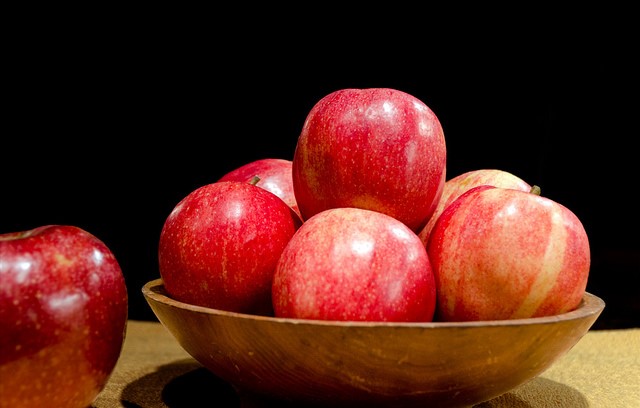
by Dorothy C. Lee | Oct 3, 2018

Bowl of apples
Photo source: bing
October is National Apple Month. “A” is for Apple. We have all heard this childhood saying as well as other apple idioms.
The Fall season has arrived and along with cooler weather, shorter days, and autumn leaves comes the bounty of Fall………apples.
In Autumn, apples fill farmers market and grocery store bins with seasonal shades of red, green, yellow, and russet. Popular varieties of apples grown in the United States include Mcintosh, Fuji, Red Delicious, Gala, Crispin, Honeycrisp, Granny Smiths, and Golden Delicious.
Nutrition
A large raw apple contains about 95 calories. Apples provide fiber, vitamins, and minerals. Apples are low in calories and high in antioxidants.
Selection
Each apple variety has its own distinctive flavor and texture. When purchasing apples choose a variety suitable for your intended use. Best apples for eating cooking baking The surface of the apple should be smooth, firm, unbroken, and free from bruises.
Preparation
Apples are delicious eaten raw. Simply rinse, cut into quarters and remove core from each section and slice. Use a vegetable peeler or a sharp knife to peel apples for cooking. To core apples for cooking push an apple corer through center of fruit from top to bottom, pull out core and stem. Coat peeled or sliced apples with lemon juice to prevent darkening. A bag of medium sized apples yields about 3 cups diced fruit or 2 ½ cups sliced fruit.
Cooking with Apples
Apples are the most versatile of all fruits. They are suitable for a variety of cooking techniques and can be used in a variety of recipes. Apples can be baked, grilled, poached, and even sautéed. Add diced apples to salads or dried and added to granola cereal. Sauté to accompany meat dishes and add to pancakes or waffle batter. For desserts, pair apples with a variety of cheeses.
Storage
Apples ripen faster at room temperature than in the refrigerator. Store apples in the refrigerator in a plastic bag to help retain moisture.
Celebrate the bounty of Fall with apples at their peak of flavor.
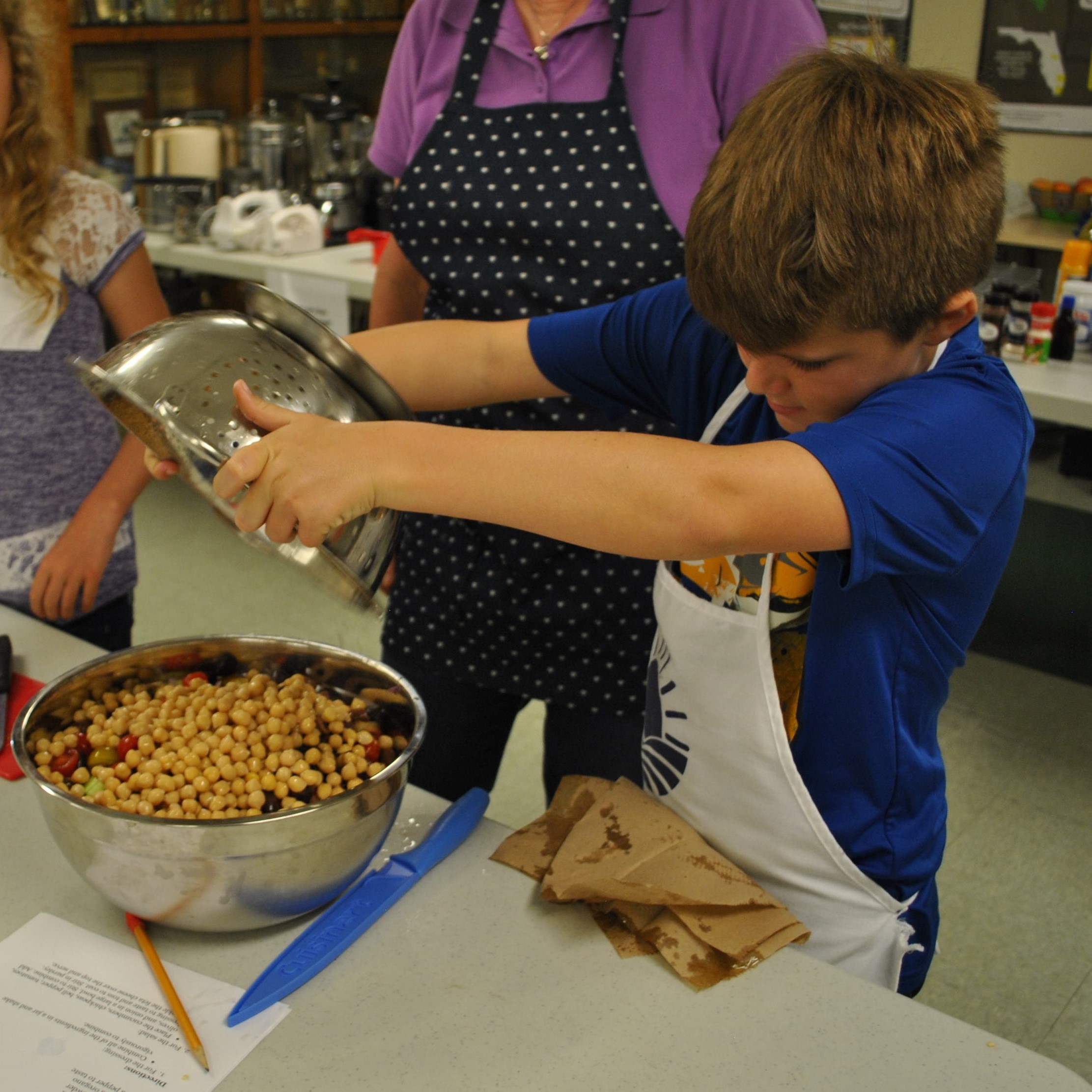
by Samantha Kennedy | Oct 3, 2018

Allowing kids to help with meal prep can encourage healthy eating. (Photo source: Samantha Kennedy)
Kids and vegetables have an historically love-hate relationship. It is not clear why this came to be, but it is clear that many kids claim to dislike vegetables even when they have not even tried them.
There are many reasons children may not have tasted vegetables. Perhaps they are not provided in the home, either due to a lack of availability, lack of knowledge about preparing them, or because parents do not make the effort to expose their kids to new foods. Or maybe kids are influenced by their peers and by the media they consume, which tell them vegetables are gross.
Whatever the reason, it is important to combat this trend and encourage kids to eat more vegetables. Fresh fruits and vegetables are a vital component of healthy eating. Healthy eating, in turn, helps reduce the risk of obesity, heart disease, diabetes, and other nutrition-related aliments.
Not sure how to start getting kids to eat vegetables? Try a few simple tricks. Cutting vegetables up into bite-sized pieces and storing them in small containers or plastic bags in the refrigerator will help make them more be appealing and accessible to smaller children.
Model healthy eating behavior. Kids are more likely to eat vegetables if they see their parents eating them. If mom and dad are enjoying trying something new, children will feel more confident in trying it as well.
Set a rule that before a child can say they do not like something, they must try it first. However, do not make it punitive. Children need to approach a new vegetable on their own instead of being forced to try it. If they absolutely refuse to try it, that is fine. Offer it to them again another time and keep trying.
Negative reinforcement such as making a child stay at the table until they eat their vegetables can negatively affect a child’s eating habits. On the flip side, rewarding kids with dessert or other treats if they eat their vegetables can also have a negative effect.
Treating vegetables as a trial a child must endure to get to something better is a surefire way to increase a child’s dislike for vegetables in the future. Vegetables should be offered in a relaxed, encouraging environment. It can take 8 to 10 tries before a child is ready to taste something new. Offering vegetables in different forms – mashed potatoes vs. baked, steamed broccoli vs. raw, etc. – is also a good way to help a child try new foods.
Serving too much of something at once can be overwhelming to a child. It is important to provide small, manageable portions of foods to kids, especially when introducing something new. Do not make it mandatory to eat all of something, either. Allow the child to eat what they want and stop when they are finished.
Offering a variety of vegetables at mealtime will provide kids with a choice and increase the chance that they will eat at least one vegetable per meal. However, avoid serving the same vegetables all the time in order to encourage them to try something new.
A final way to encourage kids to eat more vegetables is to let them get involved in the selection, purchase, and preparation. Allow them to pick a vegetable at the store. Provide them with the tools and ingredients to make their own salads. If possible, let them plant a seasonal vegetable in a container and watch it grow. The more involved kids are with their food, the more positive their eating habits will be.
For more information about getting kids to eat more fruits and vegetables, please contact Samantha Kennedy, Family and Consumer Sciences Agent, at (850) 926-3931.
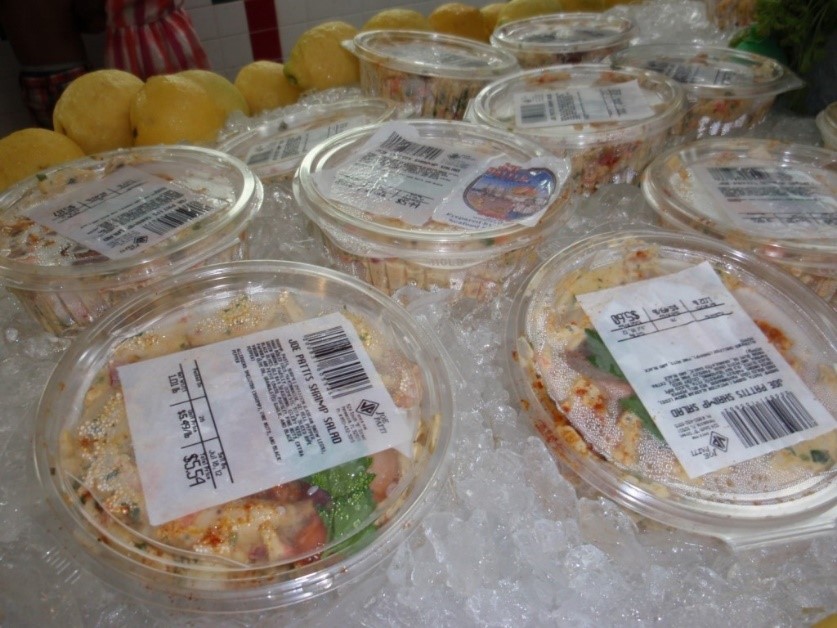
by Dorothy C. Lee | Aug 24, 2018
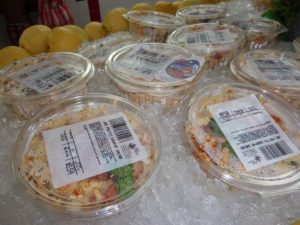
Photo source: UF/IFAS Northwest District
Fish and shellfish are easy to prepare and swimming with nutritive value. Fish and shellfish have become an even more important part of the diet as people turn to more healthful eating. People are choosing fish and shellfish more frequently for several reasons. It is economical, versatile, high in nutritive value, quick and easy to prepare, and it tastes good.
When purchasing fish, look for bright, clear, bulging eyes; reddish or pink gills; tight, shiny scales; firm, elastic flesh that springs back when pressed; and a pleasant saltwater-like odor.
Fish and shellfish are best if cooked the day of purchase but can be stored no more than two days in the coldest part of the refrigerator, preferably on ice. Frozen fish and shellfish should be kept solidly frozen until ready to thaw. Frozen seafood will remain fresh for four to six months. Cook seafood immediately upon thawing. Do not thaw fish at room temperature or in warm water because it loses moisture and flavor. Never refreeze uncooked fish.
Most fish and shellfish can be cooked using a variety of methods. Fish and seafood can be broiled, grilled, deep-fried, poached, steamed, baked, pan-fried, and sautéed. Care must be taken not to overcook fish or seafood. Fish are done when the flesh, pierced at its thickest point with a fork, flakes easily, and turns from translucent to opaque. Proper cooking develops flavor, softens connective tissue, and makes protein easier to digest.
Many seafood aficionados prefer flavoring their dishes with small amounts of salt, pepper, and occasionally lemon. The delicate taste of seafood blends exceptionally well with a variety of herbs, spices, and seeds, as long as these seasonings are used sparingly.
The next time you are in the neighborhood of your local seafood market, stop in. Remember that fish and shellfish from the Gulf are nutritious, economical, quick and easy to prepare, and taste great. So, enjoy local fish and seafood today!
Sunshine Fillets
2 pounds red snapper fillets or other fish fillets, fresh or frozen
2 teaspoons grated orange peel
1 teaspoon salt
3 tablespoons butter or margarine, melted
Dash nutmeg
2 tablespoons orange juice
Dash pepper
Thaw frozen fillets. Cut fillets into 6 portions. Place fish in a single layer, skin side down, in a well-greased baking dish, 12 x 8 x 2 inches. Combine remaining ingredients. Pour sauce over fish. Bake in a moderate oven, 350°F, for 20 to 25 minutes or until fish flakes easily when tested with a fork. Makes 6 servings.
Shrimp Kabobs
1 pound frozen raw, peeled, cleaned shrimp
1/3 cup butter or margarine, melted
1 teaspoon salt
2 large green peppers, cut into 1-inch squares
Dash pepper
8 slices bacon, cut into sixths
3 cans (4 ounces each) button mushrooms, drained
Thaw frozen shrimp. Alternate shrimp, bacon, mushrooms, and green pepper on 48 skewers or round toothpicks, approximately 3 inches long. Place kabobs on a well-greased broiler pan. Combine remaining ingredients. Pour half of the sauce over kabobs. Broil about 4 inches from source of heat for 5 to 7 minutes. Turn carefully and baste with remaining sauce. Broil 5 to 7 minutes longer or until shrimp are pink and tender. Makes approximately 48 hors d’oeuvres.

by Amy Mullins | Aug 24, 2018
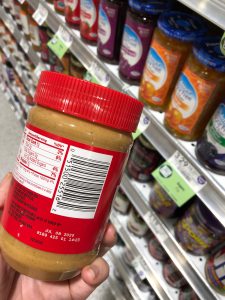
Photo source: UF/IFAS Northwest District
If your family is like most, grocery shopping is a dreaded weekly task. Typical shoppers usually have an idea of what they plan to purchase based on a previously made shopping list. Even then, it’s easy to go astray with impulse purchasing, bargain prices, and buy-one-get-one free opportunities that simply can’t be passed up! Before you know it, the shopping cart is loaded with delicious treasures just begging to come home with you.
Now that you have done the shopping, transported it home, and begun to put food items in their appropriate storage places, you realize the refrigerator, freezer, and pantry are cramped and nearly full. On a related aside, you should see my parents’ pantry. They have enough cans, boxes, and packages to feed their entire neighborhood…twice! Not to mention the two full size refrigerator/freezers that are bursting at the seams. Like my parents, I suspect many of us have a food overbuying addiction. So what happens next? Well, it’s time to clear out the old and make way for the new, of course. But how do you know what to purge and what is still good to keep?
Food Date Labeling Confusion and Food Waste
Standard or uniform language for food product dating does not exist in the U.S., which makes things tricky when it comes to deciphering expiration dates. Current Federal regulations do not require product dating (excluding infant formula), but instead allow food manufacturers to voluntarily set and display these dates on product packaging. With the lack of Federal measures, product dating enforcement is left up to individual states, resulting in consumer confusion over food safety. The U.S. wastes close to an estimated 40% of food produced annually, which equals approximately 160 billion pounds (Harvard Food Law and Policy Clinic). Of that, confusion over the meaning of date labels seems to be responsible for roughly 20% of safe and edible food wasted by consumers. Undoubtedly, this hurts purchaser’s pocketbooks and results in $29,000,000,000 of wasted consumer spending yearly (Food Date Labeling Act of 2016, 114th Congress 2D Session).
Food Quality vs. Food Safety
While cleaning out the pantry and cold storage, I also have been guilty of trashing perfectly good food. So many of us unknowingly accept the stamped date as common law not to be questioned. So what does that date actually mean?
The “open” date used by the manufacturer or retailer on food packaging is passively thought of by the consumer as the “expiration date,” or the last date a food can safely be eaten. This is a very common misconception. Food safety is not represented by this date, but rather it refers to product quality and freshness. Dates determined by food companies take into consideration such factors as ingredients, product characteristics and packaging, as well as time and temperatures associated with distribution, retail sale, and storage.
With no current standards in place, a variety of food date phrases are utilized which often are misleading to retailers and consumers. Most commonly used phrases include:
- “Best If Used By/Before” indicates when a product will be of best flavor or quality.
- “Sell-By” indicates to the retailer when the product should no longer be displayed for sale.
- “Use-By” is the last date recommended for use of the product at peak quality. This is only a safety date when used on infant formula packaging.
It’s important to remember that open dates on food products ONLY reflect food quality and NOT food safety (except for infant formula). For a list of specific foods and recommended storage time frames, check out the FoodKeeper resource at FoodSafety.gov.
Food Spoilage
Knowing the signs of spoilage will help you determine if a food is no longer fit for consumption. Although the quality date may have passed, the food is safe until it begins to spoil. Spoiled food may have a different smell, taste, and/or texture with sometimes visible discoloration. This occurs when environmental conditions (such as temperature, moisture, and oxygen) are introduced which support the growth of bacteria, molds, or yeasts. Given enough time, these microorganisms multiply rapidly and affect the safety of the food. If perishable items are not handled and stored properly, spoilage occurs much more rapidly. Learn more about proper refrigeration and food safety.
Do Your Part at Home
- Plan meals in advance and make a specific grocery list. Check the refrigerator, freezer, and pantry to utilize what you already have on hand.
- Don’t overbuy! Especially be aware not to purchase excess perishable items that are likely to spoil quickly. These may be foods that require cold storage, fresh bakery items, and fresh produce.
- Always look for and compare date labels of an item; choose the one with a later date.
- Store foods promptly and properly for food safety and best quality. Discard potentially hazardous cold food items that have not been properly refrigerated for 2 hours or more.
- Keep a thermometer inside the front of your refrigerator and check it regularly to be sure it stays below 40 degrees F.
- Thaw foods safely! Thawing in the refrigerator is the safest way, but using cold running water or defrosting in the microwave are acceptable ways to speed up the process. Never sit foods out at room temperature to thaw!
- Recognize the signs of food spoilage and promptly discard foods that smell funny, have off-flavors, obvious mold growth, or sticky or slimy textures (such as fish, poultry, and deli meats).
- Evaluate each item in your pantry and consider whether or not it’s something you want to continue to store and use or want to remove.
- High temperatures affect the shelf life of shelf-stable foods so it’s important to store dry goods and pantry items in temperatures at or below 85 degrees F. Use the “First In First Out” (FIFO) method of rotation, using older items before newly purchased ones. Read more about Shelf Stable Food Safety.
- Discard cans that are rusty, bulging, or leaking, as they are at a high risk for containing the deadly pathogen that causes Botulism. Never taste suspicious foods! Take extra caution by disposing of cans and jars into a tightly closed plastic bag before placing in an outside trash receptacle.
Help Families in Need & Keep Unused Wholesome Food Out of Landfills
Mistakenly discarded food products, not only is the U.S. but globally, have created a sad cascade of wasted resources and money with increasingly negative environmental and social implications. Food banks and local community organizations have plenty of under-served and needy families who can benefit! Remember, it’s safe to donate dry and canned goods, perishables, and other food related items that are beyond the quality date of the product.
Find a food bank near you.
We all can do our part to reduce the amount of wasted food, save money, help the environment, and help our communities!
Additional Resources:
https://www.usda.gov/oce/foodwaste/sources.htm
https://www.usda.gov/oce/foodwaste/resources/donations.htm
USDA Food Safety Information, Food Product Dating
USDA Food Labeling Fact Sheets
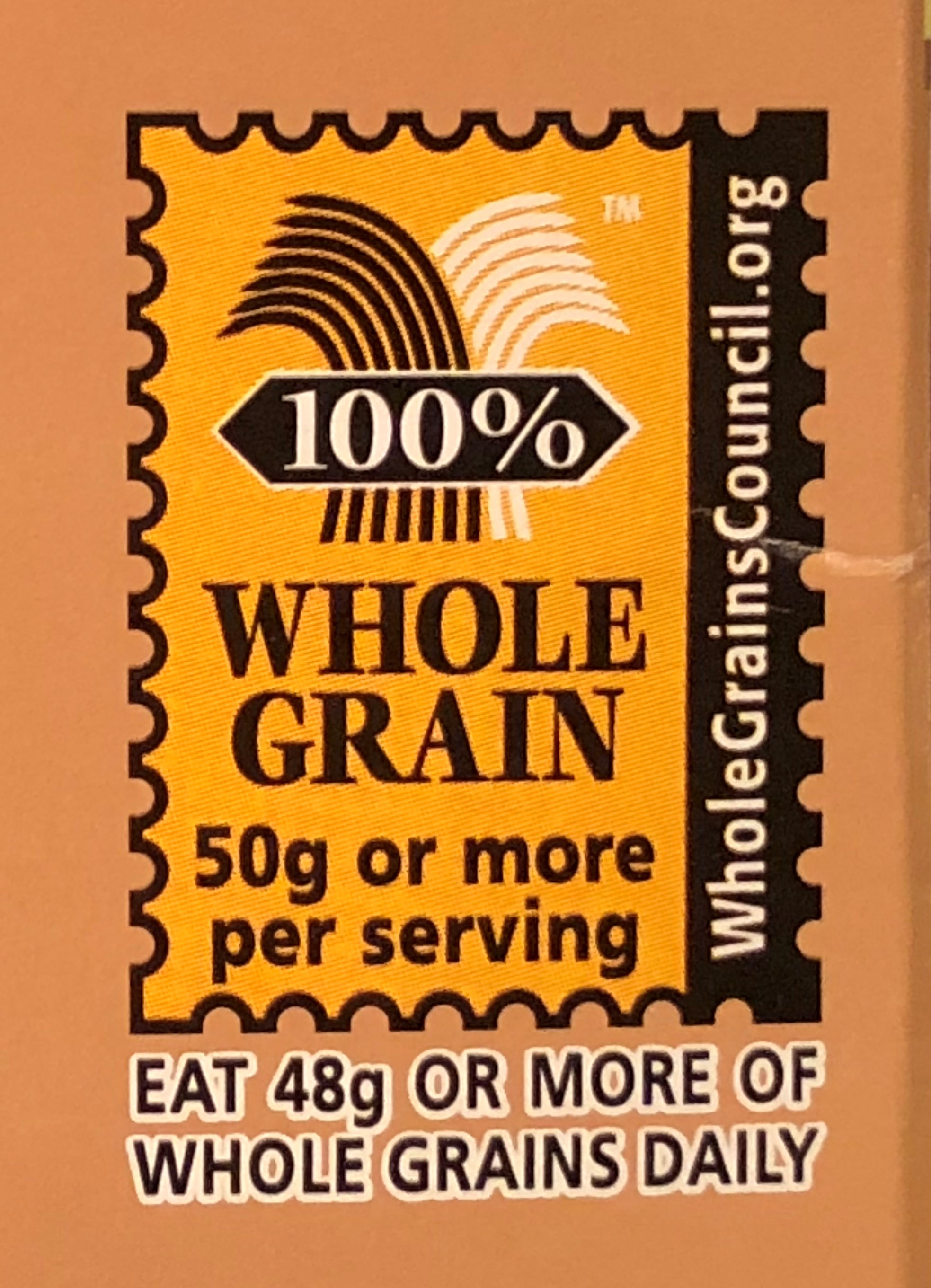
by Marie Arick | Aug 23, 2018
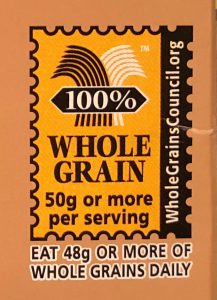
Photo credit: Marie Arick
Many Americans are more aware of whole grain food consumption as part of a healthy meal plan. In fact, the International Food Information Council’s 2015 survey found that 67% of those surveyed reported reading product labels for whole grains when shopping for packaged foods.
So, what is a whole grain? A whole grain must contain the germ, the bran, and the endosperm in the same state as it was in the field prior to harvest. Generally, most associate fiber with whole grains. In contrast, a refined grain lacks the germ and the bran that contain the fiber, B vitamins, antioxidants, and minerals. Take whole wheat, for example – it contains the trace minerals iron, zinc, copper, and magnesium, antioxidants, folate, and the following B vitamins – niacin, thiamine, and riboflavin.
Why choose whole grains? The fiber content can help to maintain a healthy weight, as it bulks once consumed, and can make one feel fuller, hence consuming fewer calories. Additionally, the fiber can aid with constipation. Other benefits of eating a diet rich in whole grains include decreasing the risk of developing type 2 diabetes, heart disease, and some forms of cancer due to the nutritional content, namely the antioxidant properties.
How much is enough? Children ideally should consume two servings minimum and adults three servings minimum each day. It is ideal for at least half of the grains you consume to be whole grains. Look for the 100% Whole Grain stamp on labels while shopping. It is a now on over 12,000 products, including cereals, breads, chips, flour, pasta, and so much more, in 58 countries.
Understanding what whole grains are and why choosing them can aid with health and well-being is important. Challenge yourself to look for the whole grain stamp and increase your daily intake, for your health.
Resources

by Angela Hinkle | Aug 23, 2018

Healthy Pantry
Photo Source: Angela Hinkle
We eat to survive, right? Yes, but when you really think about it, we eat to thrive. Food is more than calories for energy. Food brings family and friends together. It provides comfort. It makes our bodies healthy and can protect us from diseases. The next time you give to a food pantry, think about what you can give to help those in need thrive, not just survive. So, how do you donate food to thrive?
A Balanced Diet
It’s important to eat from every food group every day. It’s important to give those in need the chance to eat every food group every day. This way, they get a variety of nutrients needed for healthy bodies. Choose healthier choices from each food group. See https://www.choosemyplate.gov/ for more information.
Fruits & Veggies: Half MyPlate
- Fruits and vegetables provide so many good vitamins, minerals, fiber, and water.
- All forms count – canned, frozen, fresh, dried, and juice.
- Canned fruit in 100% juice (Lite or heavy syrup equals a little or a lot of added sugar.)
- Juices that are 100% fruit or vegetables.
- Low- or no-sodium canned vegetables (Higher sodium intake tends to go hand-in-hand with higher blood pressure.)
- Try to stay away from high-fat, high-sodium, and high-sugar syrups and sauces.
- Packaged dried fruits and veggies are both popular now.
- The more fruits and vegetables, the better!
Whole Grains
- The whole edible part of the grain plant gives us fiber and loads of nutrients to keep us healthy. They even have special parts that help fight diseases.
- Look for the word whole at the beginning of the ingredient list.
- Help pantries stock whole grain crackers, hot and cold cereals, and tortillas. Donate whole grain pasta and brown rice.
Lean Proteins
- Protein helps build and repair tissue.
- Protein provides the building blocks of muscles, bones, skin, and blood.
- Go for lower-sodium and lower-fat choices. (Most of us over the age of two don’t need that extra fat.)
- Donate tuna, chicken, or salmon in water.
- Peanut butter is always popular.
- Try offering a variety of packaged seeds and nuts.
Dairy
- The calcium in dairy foods makes strong bones and teeth.
- Try low-fat versions of shelf-stable milk.
- Non-fat dry milk is great for sauces and casseroles as well as drinking. (If used for drinking, it tastes best to add the coldest water possible.)
- Low-fat yogurt and cheeses are a nice complement for pantries with refrigeration.
- For those who can’t have dairy, offer calcium-fortified soy or almond milk, cereal, or orange juice.
So don’t just think “feed them” when you donate, think “feed them well.” Donate beyond survive. Donate to thrive.











